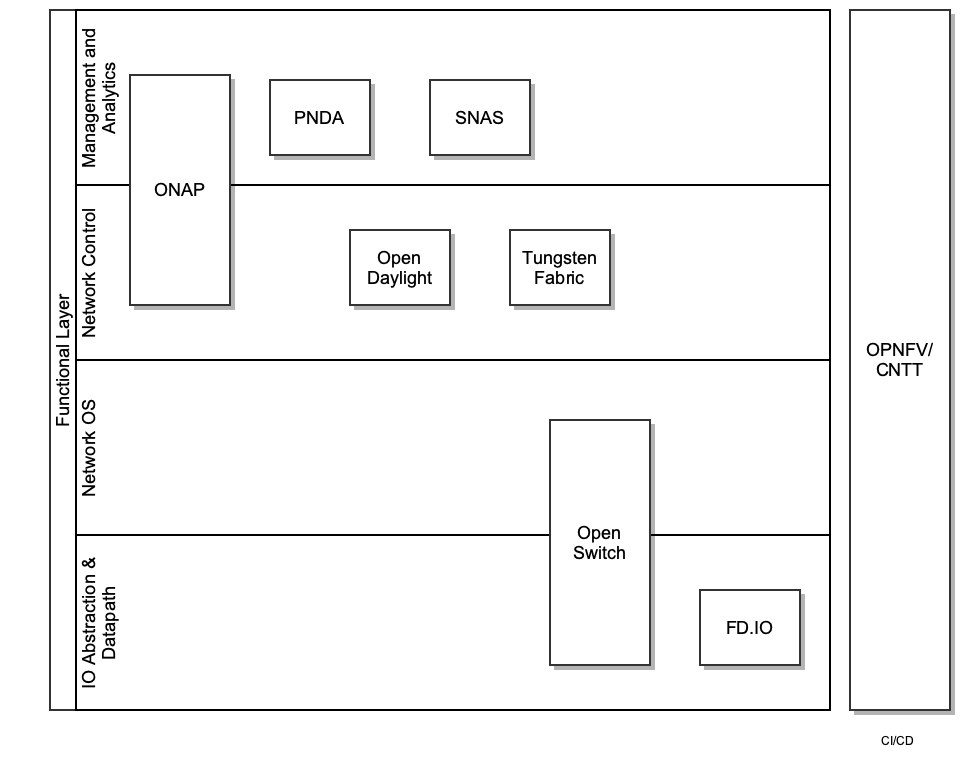External Landscape - Other open source projects, Standards Definition Organizations (SDOs)
Editor - Lingli Deng
As an open source community where operators and equipment vendors collaborate on building the reference implementation of next-generation network construction, LFN has been committed to the collaboration of standards and open source since its establishment, and has promoted cross-organizational industry cooperation by publishing a series of white papers.
The traditional communication service provider has a relatively simple business form, has a long network construction and service introduction cycle, and is accustomed to business operations based on user access, and basic network planning, construction, and maintenance according to the physical network technology field. Hence, we are now facing a partially standardized Communication Technology (or CT in short) industry chain with highly standardized network functions (or NFs in short) as well as highly customized operation and maintenance management.
Figure 1 Traditional communication network technology domain Landscape
In order to break the closed business R & D ecology and equipment R & D ecology of the communications industry, the industry's leading CSPs joined hands with vendors in creating Linux Foundation Networking (or LFN in short), as a vehicle to unite industry forces such as standards and open source, hoping to build a truly OPEN next-generation network innovation technology ecosystem.
This "openness" is embodied in the following three aspects:
- Open infrastructure: Through the dis-aggregation between software and hardware for telecommunications equipment, it is now possible for the CT industry to share common hardware infrastructure with the IT industry, and even further promote jointly to a common open hardware platform, which brings in the benefits for innovation and scale as a result of the industrial integration of CT and IT in the hardware level.
- Open NF O&M (Operation and Maintenance) : Through the dis-aggregation between the control plane, data planes and management plane of NF software, combined with a generalized and standardized end-to-end orchestration platform to stitch centralized control and management domain controllers, is driving a transition of the NF software from complex monolithic systems to sophisticated micro services. On the one hand, it can better learn and draw on the advanced technology of common IT architecture and public software components, and on the other hand, it would help lower the entry barrier standard of small and medium equipment providers and promote industrial integration at the level of CT and IT software.
- Open business customization: Through the decoupling of the general business design orchestration management platform from specific business scenarios and specific professional fields, the “Lego building block” type of business design and deployment, operation and maintenance customization capabilities are realized and opened, and basic network service providers, Communication business service providers and vertical industry service providers as well as end-user industry convergence at the business level.
Figure 2 Vision of Next Generation Network Technology Landscape (w. LFN)
As shown in the figure, in order to achieve the three-level open target vision described above, it is necessary to provide standardized touching points for interoperability:
- with common infrastructure and management platform;
- with network elements in various network technology areas for Life cycle management (or LCM in short), collection, analysis and configuration control;
- to stitch across various network technologies to achieve an end-to-end service orchestration and capability exposure platform.
Internal Landscape
LFN projects address the touching points mentioned above and offer functionality related to the different layers required for building a modern network.
It’s worth looking at the projects within the LFN umbrella in the context of the network itself.
This starts with the Transport Layer (also referred to as the 'Datapath'), where user data is moved from one point to another, speed and reliability are key. The FD.io project focuses on fast packet processing, promising to move data up to one hundred times faster. FD.io’s work applies to multiple layers of the network including Layer 2 Data, Layer 3 Network, Layer 4 Transport, Layer 5 Session and Layer 7 Application.
The next layer is the Network Operating System, where the essential software components required for building a network device are integrated and packaged together. Open Switch is a Network Operating System that abstracts the complexity and hardware implementation details of network devices, and exposes a unified interface towards the higher network layers.
The Network control layer is where end to end complex network services are designed and executed. It relies heavily on network modeling, that allows network designers to create the desired services. ONAP, Open Daylight and Tungsten Fabric take network service definitions as input, break them into their more basic building blocks, and then interface with the lower layers of the network to instantiate and control the service components. The network control layer also provides the interface to Operational and Business Support Systems (OSS/BSS) where ONAP provides the management and orchestration functions that ensure OSS/BSS can manage modern dynamic networks.
The top layer of the network functionality includes the components which provide visibility into the state of the network as well as automated network management. PNDA and SNAS can collect high volumes of network data in real time, and make them available to external management systems. ONAP is another entity that collects network performance and fault data. All the collected data can be used by the ONAP policy driven control loop automation which can take action to dynamically control the network in response to changing demand. Network faults may also be detected in this layer and in many cases the combined analytics capabilities of the projects can be used to trigger automation that provides self healing functionality to the network.
The OPNFV and CNTT projects focus on the integration of the different layers and provide tools and reference architectures for building networks. In addition, those projects provide certification programs for the network infrastructure and network functions that ensures that the different components of the network are fully compatible with each other and provide the expected functionality and performance.
